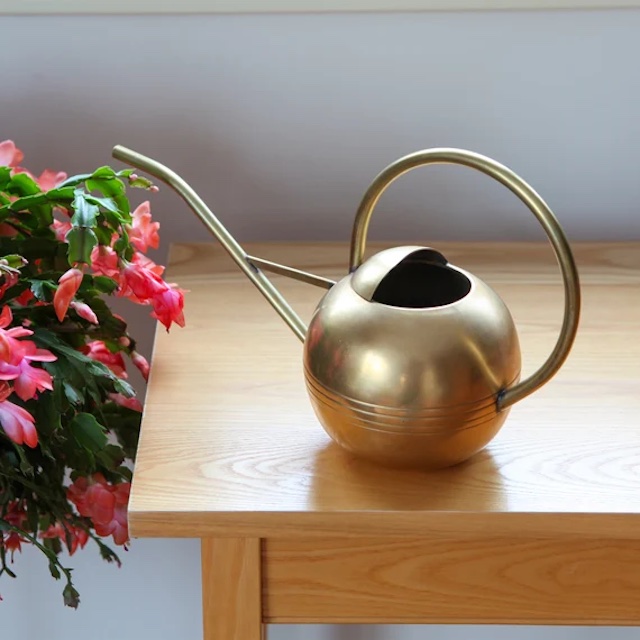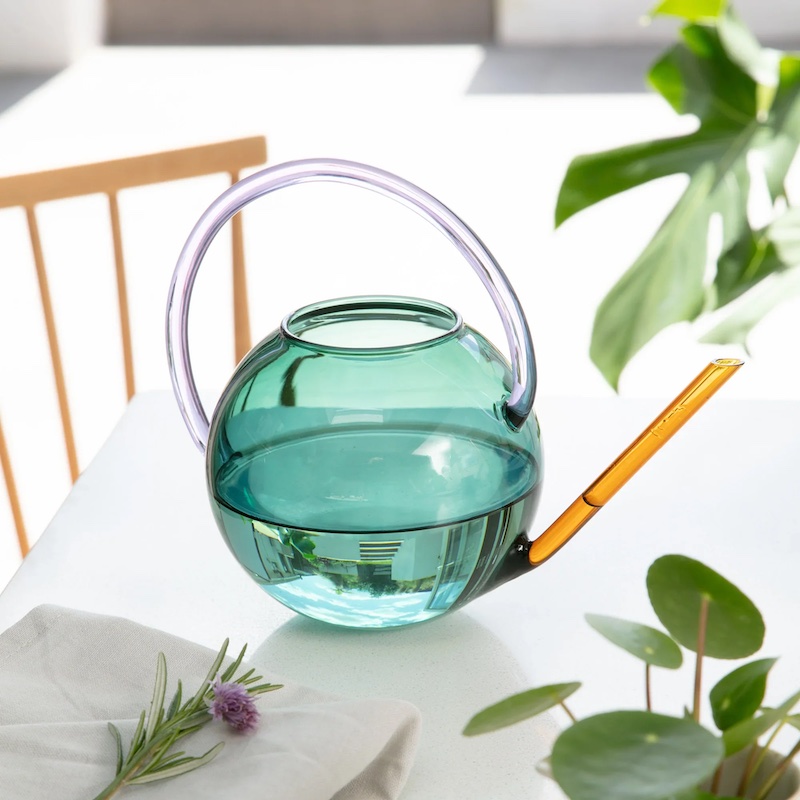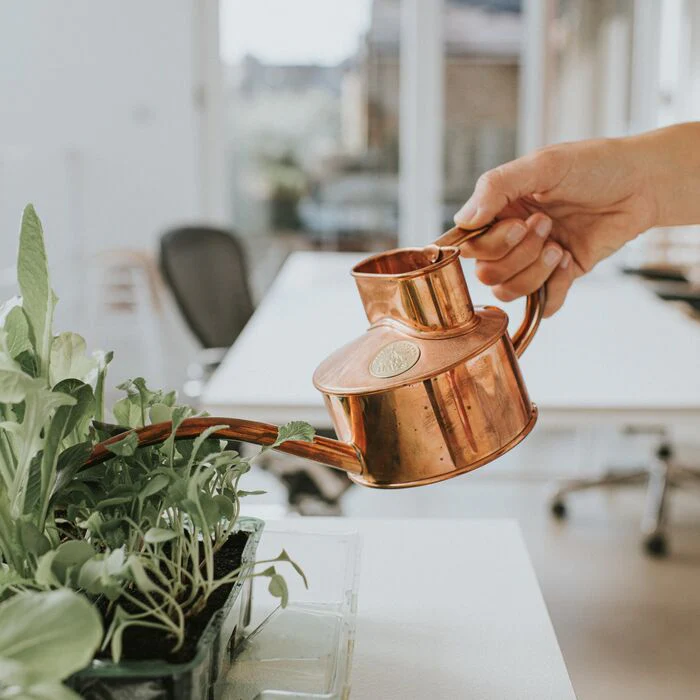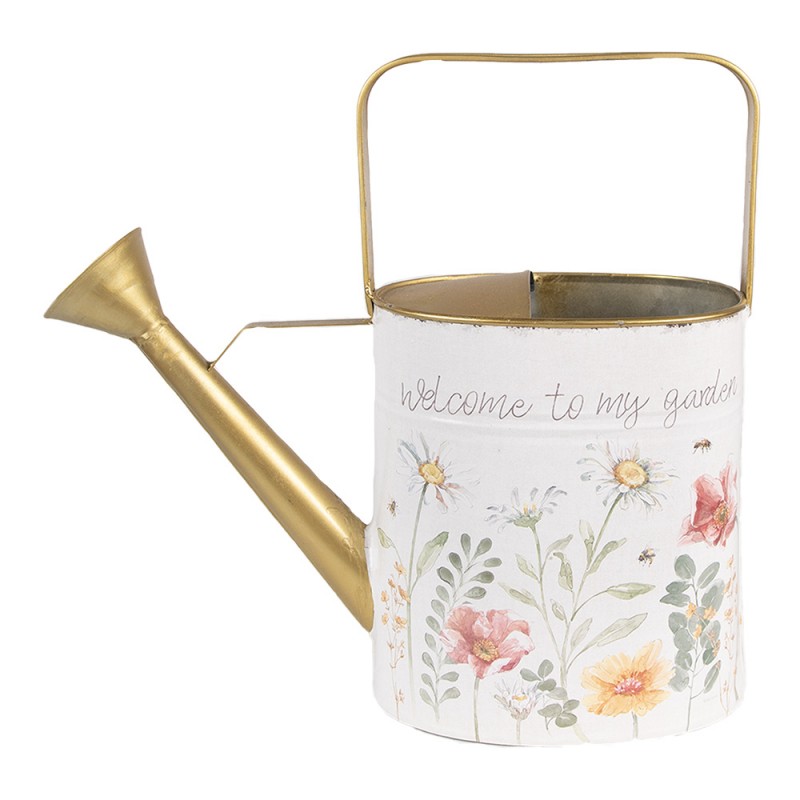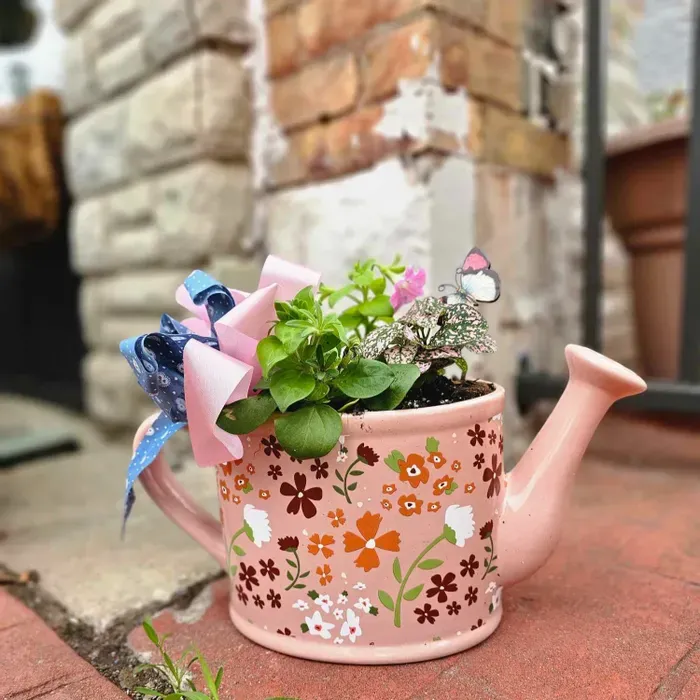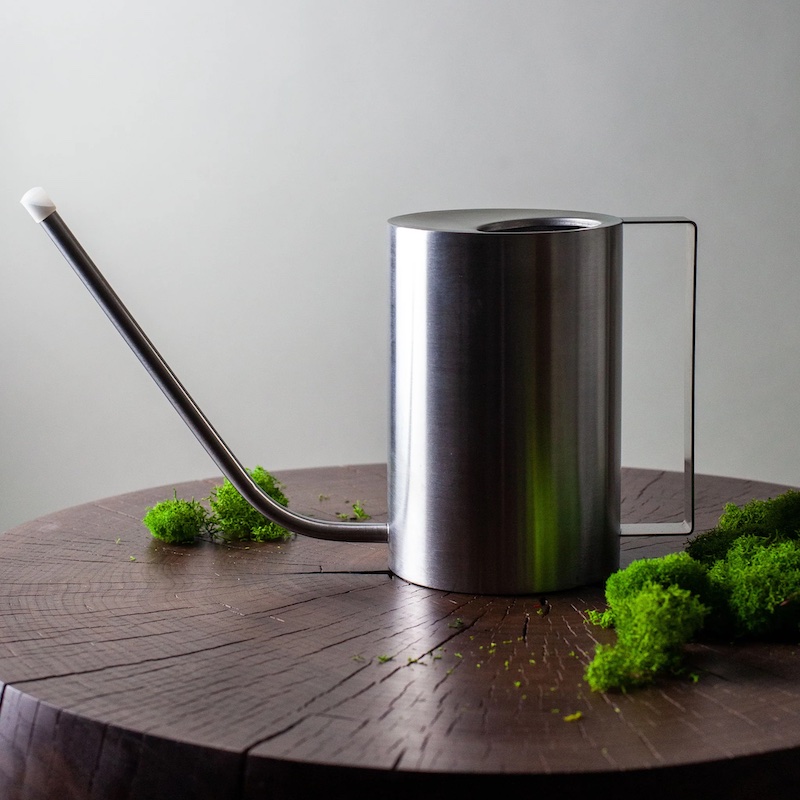
Choosing the Best Indoor Watering Can for Plant’s Health 2025
The Importance of Proper Indoor Plant Watering
Proper indoor plant watering sustains plant health. It promotes growth and prevents disease. Many indoor plants come from humid climates. They need regular, consistent moisture levels. Overwatering and underwatering can both cause harm. Roots can rot or dry out. Leaves may yellow, wilt, or drop off. Choosing the best indoor watering can helps avoid these issues. It allows for gentle, precise water delivery. This mimics natural rainfall, which plants have adapted to. A suitable can offers control over water flow and volume. This ensures that every plant gets just what it needs. Remember, the right can makes all the difference in plant care. Now, let’s explore the key features to look for in your next best indoor watering can.
Key Features to Look for in an Indoor Watering Can
When searching for the best indoor watering can, certain features make some standout. Consider these essentials:
- Capacity: Size matters. You’ll want a can that holds enough water for your indoor garden but isn’t too heavy when full.
- Material: Good cans come in different materials. Plastic is lightweight and affordable. Metal options lend durability and style. Go for one that fits your routine and decor.
- Spout Design: A spout with a gentle flow is key for precise watering. Look for a can with a narrow spout to reach between leaves without splashing.
- Balance and Handle Design: A comfortable grip and a well-balanced can ease your watering chores. It should feel good in your hand even after filling it up.
- Ease of Filling: Your watering can should fit under the sink tap easily. A wide opening helps avoid spills.
- Detachable Spout Heads: Some cans offer detachable heads. These can provide a soft shower or a steady stream, depending on your plant’s needs.
- Water Level Indicator: For those who prefer precision, some cans have level indicators. This helps you monitor how much water you’re giving to each plant.
Choosing the best indoor watering can with these features will streamline your plant care routine. It also ensures your plants thrive with just the right amount of water.
Types of Indoor Watering Cans
When hunting for the best indoor watering can, you’ll come across diverse types. Each serves different needs and preferences. Dive into these common types:
Long Spout Watering Cans
Long spout watering cans are optimal for reaching into thick foliage without disturbing plants. Their extended spouts ensure water reaches the soil, not the leaves, preventing fungal diseases. These cans are great for deep pots and hanging baskets. With a narrow and lengthy spout, you get precise control, minimizing spills.
Mini Watering Cans for Small Plants
Have a collection of succulents or small potted herbs? Mini watering cans deliver a fine amount of water for these delicate plants. They’re lightweight and easy to handle. Plus, their compact size fits snugly on a windowsill or shelf, always ready for quick touch-ups.
Decorative Watering Cans for Interior Aesthetics
Who says utility can’t be stylish? Decorative watering cans add a splash of charm to any room while fulfilling their purpose. They come in vibrant colors, elegant styles, and various materials. Some even serve as planters or vases when not in use, blending seamlessly with your decor.
Material Considerations for Durability and Style
Choosing the best indoor watering can isn’t just about function. It’s also about finding a piece that stands up to frequent use and complements your home’s interior. Here’s what to consider when it comes to materials:
Plastic Watering Cans
Plastic is a common choice for indoor watering cans. It’s lightweight, making it easier to carry around. Plastic cans resist rust and are often more affordable. However, they can vary in quality. Look for high-grade, BPA-free plastics for safety and longevity.
Metal Watering Cans
Metal cans offer durability and a classic look. They can withstand drops and rough handling. Metals like stainless steel or galvanized iron prevent rusting. Choose these if you desire a timeless style that lasts years.
Ceramic Watering Cans
Ceramic watering cans are pieces of art in themselves. They add a touch of elegance to your indoor garden. They’re heavier and more delicate than other materials but offer unique charm and sophistication.
Silicone and Other Modern Materials
Some modern watering cans incorporate silicone or rubber elements for flexibility and grip. These innovative materials may offer features like collapsibility for easy storage.
When picking the best indoor watering can for your needs, consider how often you’ll use it, the size of your indoor garden, and your personal aesthetics. Go with a material that meets your practical needs and suits your style preferences. Whether you favor practicality, durability, or design, there’s a material perfect for your watering tasks.
Top Indoor Watering Can Picks for 2025
Selecting the best indoor watering can is crucial for gardening enthusiasts. For 2025, we’ve curated a list of top picks to ensure optimal plant care. These watering cans combine functionality with style and durability, ensuring a pleasurable gardening experience.
Long Spout Watering Cans
Our 2025 selection includes long spout cans, ideal for reaching into dense plants. These cans distribute water evenly, right to the base of your plants. Their design minimizes risk of leaf fungus and spills. Their spouts provide precision, essential for plants in deep pots or hanging baskets.
Mini Watering Cans for Small Plants
For those who love smaller plants, our mini watering cans are perfect. They are light and simple to handle. Small in size, they fit easily in tight spaces, like shelves or windowsills. We’ve tested each one to ensure it offers the right amount of water for delicate plants.
Decorative Watering Cans for Interior Aesthetics
We also showcase decorative cans that double as home decor. These stylish options come in bold colors and elegant designs. They not only water plants efficiently but also enhance your room’s look. Some even act as vases, merging utility with aesthetics.
Our top picks for the best indoor watering can in 2025 cater to diverse needs and tastes. They make plant care easy and integrate well with your lifestyle. Choose one that fits your indoor gardening routine and personal style.
Ergonomic Design: Ensuring Comfort in Use
Ergonomic design is key for selecting the best indoor watering can. Comfort in use is just as important as the watering can’s functional features. When you water plants regularly, a can that’s awkward or heavy can strain your hands and wrists. An ergonomic watering can fits comfortably in your grip and maintains balance, even when full.
Here are some ergonomic features to look for:
- Lightweight Build: A can that’s easy to lift and move reduces fatigue. Lightweight materials help make this possible.
- Curved Handles: A handle with a natural curve can make holding and pouring more comfortable. This shape supports your hand’s natural position.
- Balanced Design: The best indoor watering cans should feel stable and easy to tilt. This balance helps prevent spills and reduces strain on your body.
- Non-Slip Grip: Look for a can with a handle that doesn’t slip in wet conditions. A secure grip ensures safe and precise pouring.
An ergonomic watering can improves your watering experience. It helps prevent discomfort during lengthy plant-care sessions. Remember to test the feel of a can before you purchase. Lift it, hold it, pretend to water – find one that feels like an extension of your hand.
Innovative Watering Cans: Exploring New Features and Technologies
With 2025’s gardening scene evolving, the best indoor watering can is also advancing. Manufacturers are bringing out cans with new features and technologies. These innovations aim to enhance plant care and user experience.
Here are the latest trends to look for:
- Self-Watering Cans: These cans do some of the work for you. They release water slowly over time, perfect for when you’re away.
- Digital Watering Reminders: Some watering cans now come with built-in timers or apps. They remind you when it’s time to water, ensuring your plants stay hydrated.
- Adjustable Flow Rates: Advanced cans offer settings for varied water flow. You can switch from a gentle mist to a steady stream with ease.
- Eco-Friendly Materials: Today’s best indoor watering cans are not just about style. They also respect the environment with recycled or biodegradable materials.
- Integrated Measuring Tools: Precision is key in watering. Select cans have built-in rulers or measuring reservoirs to help you give the exact amount of water.
These innovative watering cans are transforming the way gardeners care for their indoor plants. They add convenience and precision, setting the standard for the future. When choosing your next watering can, consider these modern options to make indoor gardening more efficient and enjoyable.
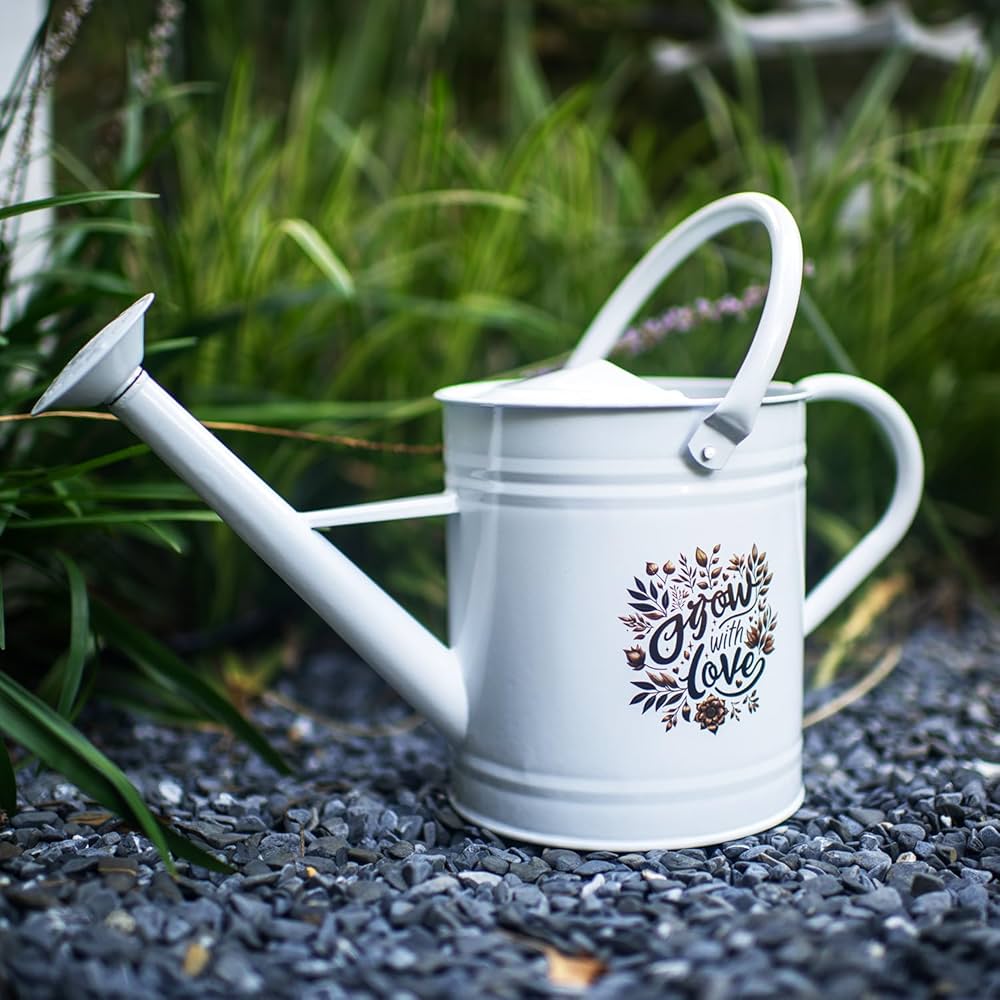
The Decorative Watering Can Designs for Indoor Plants
The Importance of Proper Watering for Indoor Plants
Ensuring your indoor plants receive the right amount of water is crucial for their health. Over-watering can lead to root rot, a common issue that hinders plant growth. Under-watering, on the other hand, can dry out the roots and weaken the plant. A decorative watering can not only add style to your plant care routine but also help you water effectively. It’s important to understand each plant’s unique watering needs. The right watering can design can offer precise control over the water flow. This control enables you to reach the soil directly without splashing and wetting the leaves, which can cause fungal infections.
An appropriate watering can with a long spout is ideal for targeted watering, reducing water wastage. Using a decorative watering can also serves as a visual reminder to care for your plants regularly. Keep in mind that the type of indoor plant you have can dictate the kind of watering can you might need. For example, succulents require less frequent watering than tropical plants, which may need a more consistent watering schedule. Balancing beauty with functionality, a decorative watering can be a perfect tool for maintaining the health and vitality of your indoor plants.
Classic Watering Can Designs and Their Appeal
Classic watering can designs have stood the test of time due to their functional elegance. These designs typically feature a balanced combination of a curved handle and a long spout. The iconic shape is not just for looks; it provides an ergonomic grip for ease of watering. Often made from materials such as galvanized steel or copper, these cans offer durability. The rustic aesthetic of a classic decorative watering can serves as a nod to traditional gardening.
In addition, the patina that develops on metal cans over time adds a touch of antiquity. It appeals to those who enjoy vintage or rustic home decor. Moreover, many plant enthusiasts believe traditional designs blend seamlessly into both indoor and outdoor settings. This timeless appeal makes the classic decorative watering can a popular choice for gardeners. Its simplicity does not clash with the natural beauty of the plants. Also, a classic can is often a go-to for those seeking a reliable and understated tool that gets the job done. Using such watering cans not only ensures efficient hydration for your plants but also adds a decorative element to your plant care routine.
Modern Watering Cans for a Contemporary Look
Modern watering cans offer more than just utility; they enhance the aesthetic of your indoor garden. These cans showcase sleek lines, bold colors, and innovative designs that fit well in contemporary spaces. Unlike classic styles, modern decorative watering cans often emphasize minimalism and functionality. Manufacturers use materials such as stainless steel, plastic, or recycled materials to capture a clean, sophisticated vibe.
Distinctive Shapes and Designs: The modern decorative watering can might come in unexpected shapes. Some are cylindrical, others might be rectangular. The handles and spouts might feature artistic curves or geometric angles. These designs can double as decor when they’re not in use.
Vibrant and Neutral Colors: Color is a significant aspect of modern cans. They are available in an array of colors, ranging from bright, eye-catching hues to understated, chic shades. It allows gardeners to match their watering can with their interior design palette or plant pots.
Combining Form and Function: High functionality is key in modern designs. They often come with detachable spouts for different watering pressures and ergonomic handles for comfortable grip. Designers integrate these features without compromising the watering can’s sleek silhouette.
Innovative Materials: The modern decorative watering can is also about materials. Designers often choose durable and lightweight alternatives over traditional metals. Some modern cans are made to be environment-friendly, suggesting a shift towards sustainability in gardening tools.
Multifunctional Accessories: Many modern cans include additional features such as measurement markings for precise watering, or in-built filters to prevent debris from clogging the spout. These accessories promote a more efficient watering routine.
In conclusion, when you choose a modern watering can, you’re selecting a tool that meets your watering needs while reflecting your style. The modern decorative watering can is a statement piece that stands out among classic options and provides an effortless blend of form and function.
Decorative Watering Cans as Functional Art Pieces
Choosing a decorative watering can that functions as an art piece is not just practical; it adds aesthetic value to your plant care. These watering cans become a focus in your indoor space, hinting at your personal style and love for gardening. When not in use, they can sit on a shelf or table, merging with your home’s decor as a standalone sculpture. Many owners feel proud to display these cans as part of their interior landscape.
Statement Designs: The unique designs of these decorative watering cans turn them into conversation starters. An artistic watering can might feature intricate patterns, bold graphics, or hand-painted details that showcase your personal taste.
Material Craftsmanship: Craftsmanship is central to these art pieces. The materials used, such as hand-blown glass or custom-forged metal, bring a high-quality and unique touch that mass-produced items cannot match.
Versatility in Use: Despite their artfulness, functional art watering cans are crafted to be fully functional. This ensures you can water plants with ease while enjoying the beauty of your can.
Reflecting Personal Aesthetics: Whether you favor a bohemian, minimalist, or avant-garde style, there’s a decorative watering can to suit your aesthetic. It’s the perfect way to infuse your personality into the daily ritual of plant maintenance.
By selecting a watering can that is both a functional tool and a piece of art, you create a more engaging and visually pleasing plant care experience. It’s about celebrating the beauty of the everyday and bringing joy to what might once have been considered a mundane task.
Eco-Friendly Watering Can Options
In the pursuit of sustainability, eco-friendly watering can options have emerged. These cans support green living and reduce environmental impact. Made from biodegradable materials or recycled products, they help gardeners maintain eco-conscious practices.
Biodegradable Materials: Some eco-friendly cans are crafted from natural materials that decompose over time. For instance, bamboo, which is fast-growing and sustainable, is a popular choice. It breaks down after its useful life, leaving minimal environmental footprint.
Recycled Plastics: Manufacturers are repurposing plastic waste to create watering cans. This approach keeps plastics out of landfills and oceans. Plus, it reduces the need for new plastic production.
Upcycled Designs: Creative minds turn old items into unique watering cans. Old bottles or containers get a second life as a decorative watering can. This not only saves resources but also adds a personal touch to your gardening tools.
Water Conservation Features: Some eco-friendly cans include features that promote water conservation. They might have nozzles that control water flow or systems that reuse household water.
Sustainable Production Processes: The creation of the can matters as well. Brands that use solar power or other renewable energy in production are making strides. They offer products with a lower carbon footprint.
By choosing an eco-friendly decorative watering can, you contribute to a healthier planet. You also support the industry moving towards sustainable practices. Next time you’re shopping, consider options that are kind to the earth and stylish for your home.
Watering Can Materials: Pros and Cons
When selecting a decorative watering can, the material is a crucial factor to consider. Here’s a quick look at the pros and cons of various materials commonly used:
Metal Watering Cans:
Pros: Metal cans are sturdy and long-lasting. They can withstand frequent use. Their weight gives them a stable base when full, reducing the risk of tipping over. Over time, metals like copper develop a unique patina adding to their charm.
Cons: They can be heavy, especially when filled with water, making them less ideal for those with limited strength. Metal cans may rust if not properly cared for. They are also usually more expensive than plastic options.
Plastic Watering Cans:
Pros: Plastic is lightweight, making it easy to carry, even for those with less hand strength. It’s often more affordable and comes in a variety of colors.
Cons: Plastic can degrade over time, especially when exposed to sunlight, leading to cracks and leaks. Some may not like the feel of plastic or its appearance compared to metal or ceramic cans.
Ceramic Watering Cans:
Pros: Ceramic offers a classic look and can be glazed in many decorative finishes. They often have intricate designs and can serve as a decor piece.
Cons: They are fragile and can crack or break if dropped. Ceramic cans are also heavier and typically more expensive due to their craftsmanship.
Stainless Steel Watering Cans:
Pros: Stainless steel is rust-resistant and durable. It has a sleek, modern appearance and is often used in contemporary designs.
Cons: These can show water spots and fingerprints, requiring more maintenance. Like other metal cans, they can be heavier and pricier.
When choosing your decorative watering can, weigh the pros and cons of each material against your needs and style preferences. Consider durability, weight, cost, and aesthetics to find the perfect fit for your indoor plant care.
Tips for Choosing the Right Watering Can for Your Plants
Selecting the correct decorative watering can for your indoor plants involves more than just style. Here are some tips to help you make the best choice for the health of your plants and the aesthetics of your home.
Consider Plant Needs: Each plant has distinct watering requirements. Ensure the can’s size and spout design fit the needs of your plant species.
Evaluate Space: Look at your indoor space. Choose a size that is easy to handle and store in your home.
Check the Spout: Long spouts reach the base of plants with ease, preventing leaf wetness. A detachable spout can offer versatility.
Test Ergonomics: Pick it up, if possible. It should feel comfortable in your hand, even when full.
Think About Durability: A sturdy can lasts longer. Metal can be strong, but also heavy. Plastic is light but may not last as long.
Assess Capacity: A larger capacity means fewer trips to refill, but it will be heavier. Balance convenience with comfort.
Match Your Decor: A decorative watering can should also fit your room’s style. Choose one that complements your interior.
Look for Extra Features: Measurement markings and filters are helpful for precise and clean watering.
By keeping these tips in mind, you’ll find a watering can that serves as a practical tool and enhances your home decor. Remember, the best choice will blend functionality with personal taste, making plant care a pleasure.
Creative DIY Watering Can Ideas
Adding a personal touch to your gardening tools can be rewarding, and DIY watering can ideas offer just that. Here are some creative suggestions to get you started:
Repurpose Household Items: Look around for items that can be transformed. An old teapot or a milk jug can become a unique watering can with a few modifications. Drill holes in the lid for a makeshift spout.
Decorate with Paint: Give an old can a new life with a coat of paint. Use stencils to add patterns or let your creativity flow with freehand designs. Make sure to use waterproof paint.
Add Comfort to Handles: Wrapping the handle with twine or soft fabric can add comfort and style. It’s a simple change that makes a big difference in handling the can.
Create a Mosaic Look: Glue pieces of broken ceramic or glass to a plain watering can. This not only recycles but also creates a colorful masterpiece.
Incorporate Nature: Attach shells, stones, or wooden elements to your can. These can give a rustic or beachy feel to your watering routine.
Go Green with Bottles: Plastic bottles come in handy for small plants. Poke holes in the cap, fill with water, and you have an instant watering device.
By exploring these DIY options, you’re on your way to having a decorative watering can that’s both functional and expressive of your personal style.
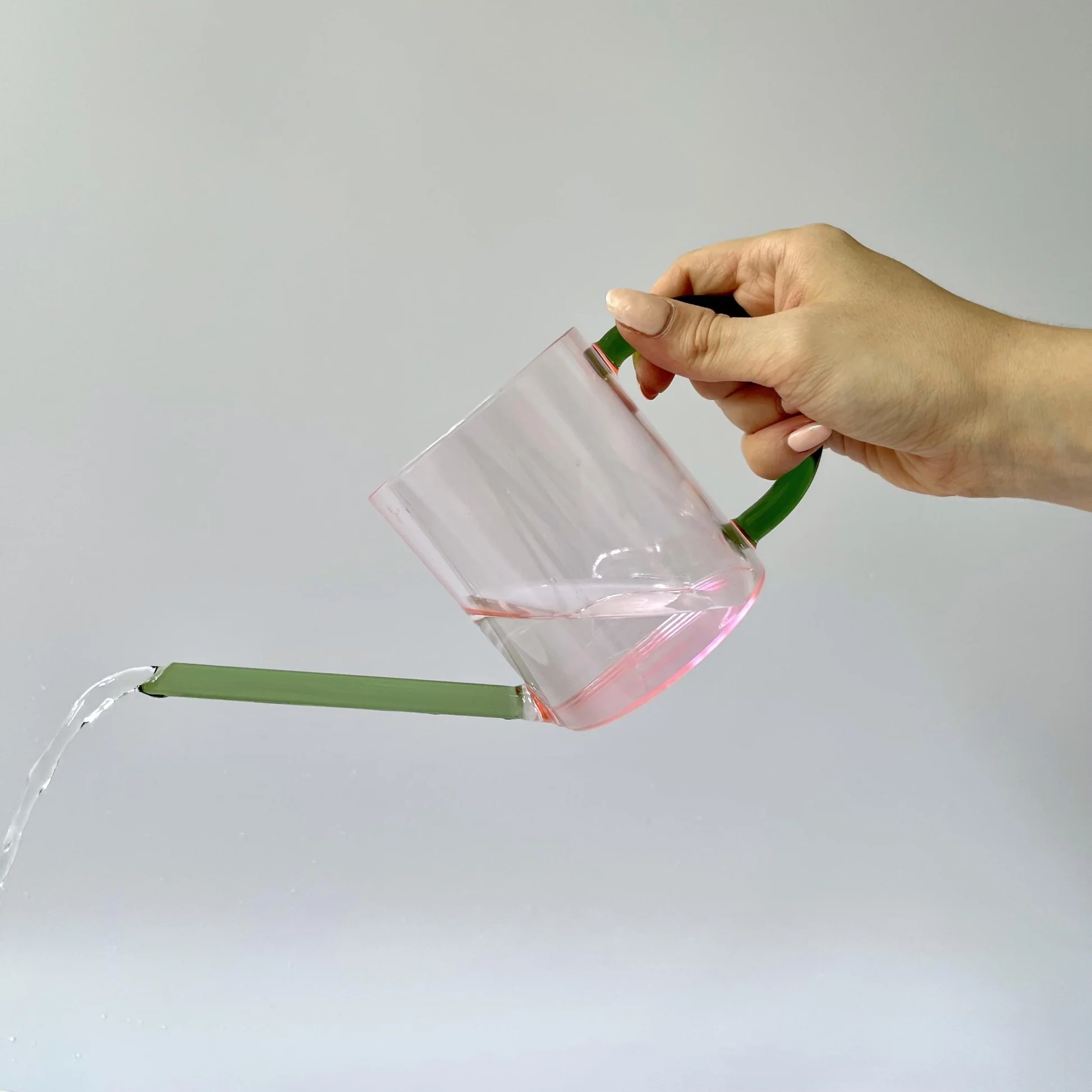
Small Watering Can: Perfect for Indoor Gardens
Benefits of Using a Small Watering Can for Indoor Plants
Embracing the use of a small watering can offers several benefits for indoor gardening enthusiasts. Choosing this compact tool ensures you provide your plants with the right amount of water, crucial for their growth and health. Here are the key advantages:
- Precision Watering: The slender spout of a small watering can enables precise watering, targeting the soil rather than the leaves. This helps prevent overwatering and reduces the risk of plant diseases.
- Ease of Use: Its lightweight design makes a small watering can easy to handle and maneuver, especially in tight spaces. This brings comfort and reduces the strain on your arms and wrists during extended gardening sessions.
- Controlled Water Flow: Small watering cans allow better control over the flow of water, crucial for delicate plants or seedlings that can easily be disturbed by a strong stream.
- Avoids Water Waste: With its limited capacity, a small watering can promotes conservative water usage. You’re less likely to give your plants more water than they need, preventing waste and overwatering.
- Perfect for Small Gardens: If you only have a few plants or a mini indoor garden, a small watering can is the ideal size. It keeps the watering process simple and efficient.
- Portability: Whether you’re tending plants in various rooms or on different levels of your home, a small watering can is portable and convenient to carry around. It makes the task of watering plants less of a chore.
In summary, a small watering can is a perfect tool for indoor gardeners. It promotes plant health, conserves water, and makes the process of watering effortless and precise. Its many benefits ensure that your indoor plants will thrive.
Key Features to Look for in a Small Watering Can
When shopping for a small watering can for your indoor plants, not all models are equal. To get the most benefits, you should look for several key features that enhance the watering experience and cater to the needs of your plants. These key features include:
- Ergonomic Design: Aim for a can with a comfortable grip and a balanced weight distribution when full. This reduces hand fatigue during prolonged use.
- Long Spout: A long, narrow spout provides a precision stream and easy access to hard-to-reach plants.
- Volume Markings: Inside volume measurements help you track how much water you’re using, aiding in consistent care.
- Durable Materials: The can should be made from sturdy materials to resist leaks and handle daily use.
- Compact Size: A small size not only saves space but ensures ease of storage when not in use.
- Detachable Rose: A detachable sprinkle rose allows for gentler watering when needed and is easy to clean.
By incorporating these features into your selection criteria, you ensure a pleasant and effective watering experience. A well-chosen small watering can becomes an indispensable ally in keeping your indoor garden.
The Best Materials for Small Watering Cans
When selecting a small watering can for your indoor plants, the material is a vital factor. Different materials not only impact the can’s durability but also affect its usability and longevity. Here’s a look at the best materials to consider:
- Plastic: Lightweight and affordable, plastic watering cans are easy to carry and are a practical choice for casual gardeners. Ensure the plastic is high-quality and free from BPA to avoid chemicals leaching into the water.
- Metal: Metal cans, such as those made from stainless steel or galvanized iron, offer a robust and stylish option. These are long-lasting and resist rust, but they can be heavier than plastic.
- Ceramic: A ceramic small watering can adds a touch of elegance to your indoor gardening tools. While heavier and more fragile, they provide an aesthetic appeal unmatched by other materials.
- Recycled Materials: Environmentally conscious gardeners might opt for cans made from recycled materials. Such options deliver sustainability without compromising on quality or performance.
Choosing the right material for your small watering can not only benefits your plants but also contributes to a seamless gardening experience. Make your selection based on the balance between practicality, durability, and your personal values, such as eco-friendliness.
Design and Aesthetics: Matching Your Indoor Decor
A small watering can is not just a gardening tool. It also complements your indoor decor. When selecting one, consider its design and how it matches your interior style. Here are points to keep in mind:
- Color and Finish: Choose a can with a color or finish that fits your room’s palette. Bright colors add pop to neutral spaces, while metallics bring sophistication.
- Shape and Form: Look for sleek lines or interesting shapes that serve as a functional decor piece. A unique watering can becomes a conversational item in your home.
- Decorative Elements: Some small watering cans come with embossed patterns or artistic designs. These elements enhance their visual appeal and reflect your personal taste.
- Multi-functionality: Get a watering can that doubles as a vase for a practical yet stylish option. When not in use for watering, it can hold fresh flowers.
- Storage Display: Consider how the watering can will look when stored. A pretty can deserves a spot on open shelving, becoming a part of the decor even when idle.
Remember, the right small watering can should be both useful and beautiful. With careful selection, your watering can will not only nourish your plants but also elevate your indoor garden as a piece of art.
How to Properly Use a Small Watering Can for Indoor Gardening
Using a small watering can correctly is vital for the health of your indoor plants. Follow these tips for the best results:
- Check Soil Moisture: Before watering, always check if the soil is dry. Use your finger to test the top inch of soil. Water only if it feels dry.
- Water Evenly: Aim the spout close to the soil to avoid splashing on leaves. Pour water evenly around the base of each plant.
- Use Room Temperature Water: Fill your can with water that’s at room temperature. Plants may react badly to water that is too cold or hot.
- Control Pouring Speed: Use gentle pressure on the handle to control the flow. Avoid flooding the plant by pouring slowly.
- Empty Excess Water: After watering, empty out any water that collects in the saucer beneath the pot. This prevents root rot.
- Consistent Watering Schedule: Stick to a regular watering schedule. Overwatering and underwatering both harm plant health.
By following these straightforward steps, you can master the use of a small watering can. Your indoor garden will flourish with proper watering techniques. Keep these points in mind every time you water, ensuring healthy and happy plants.
Maintenance and Cleaning Tips for Small Watering Cans
To keep your small watering can in top shape, regular maintenance and cleaning are key. Here’s how to care for your can:
- Rinse After Use: Each time you water, rinse the can with clean water. This removes old water that might breed bacteria.
- Wash Regularly: Give your can a thorough wash with soapy water. Do this at least once a month to prevent dirt buildup.
- Dry Completely: After washing, dry your can well. Store it upside down to let excess water drip out.
- Check for Leaks: Inspect your can for any leaks or rust spots. Fix leaks promptly to avoid water wastage.
- Avoid Harsh Chemicals: When cleaning, steer clear of harsh chemicals. They can harm the can’s material and plants.
- Detachable Parts: If your can has a rose or other parts, remove and clean them separately. This ensures all nooks are debris-free.
By following these maintenance and cleaning tips, you extend the life of your small watering can. Your plants will thank you for using a clean, well-functioning tool. Keep these steps in mind to ensure your watering can remains a trusty companion in your indoor gardening journey.
Top Rated Small Watering Cans on the Market
Finding a top-rated small watering can can be quite a task. Yet, certain products have garnered praise from indoor gardening enthusiasts for their quality and design. When searching for the best small watering can, consider options that users love and recommend. Here are a few top-rated cans known for their functionality and style:
- Stainless Steel Models: These cans offer durability and a classic look that appeals to many. Look for ones with ergonomic handles and long spouts for ease of use.
- Designer Plastic Cans: Some brands have mastered the art of creating stylish plastic watering cans. These are lightweight, come in various colors, and often feature innovative designs.
- Compact Ceramic Options: While less common, ceramic small watering cans are praised for their beauty. They fit well with home decor and make watering plants a luxurious experience.
- Eco-friendly Choices: Cans made from recycled materials or those that promote sustainable practices are gaining popularity. They are perfect for the eco-conscious gardener.
- Multi-functional Cans: Look for small watering cans that serve more than one purpose. Some can double as a decorative vase, blending utility with aesthetics.
The market offers a variety of small watering cans to meet different needs and preferences. Check for reviews and ratings before making your choice to ensure you get a reliable and well-liked product.
Crafting Your Own DIY Small Watering Can
For those who love customizing their gardening tools, crafting a small watering can is a rewarding project. Not only does it allow you to create a can that’s perfectly suited to your plants’ needs, but it also gives you a chance to add a personal touch to your gardening arsenal.
Here are steps to make your own DIY small watering can:
- Choose a Container: Start with a suitable container. It could be a plastic bottle or a small bucket. Select one that’s easy to handle and fits your space.
- Make a Spout: Cut or shape a spout on your container. A funnel works well for this. Ensure it’s narrow for precise watering.
- Punch Holes for Watering: If you’re using a bottle cap or a lid, punch small holes in it. This will simulate a sprinkle rose effect.
- Decorate Your Can: Personalize with paint or stickers. This step is where you can get creative and make it match your decor.
- Test It Out: Fill with water and check for leaks. Make sure the flow is steady and manageable.
Remember, your DIY small watering can should be functional and fit well with your indoor gardening routine. With these simple steps, you can turn an everyday item into a useful, customized gardening tool. Whether you’re a seasoned gardener or just starting out, this project is a fun and practical way to enhance your indoor gardening experience.
